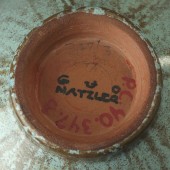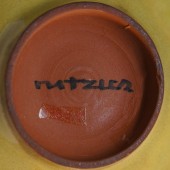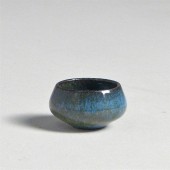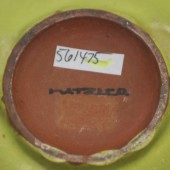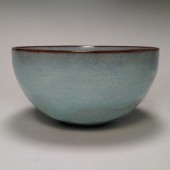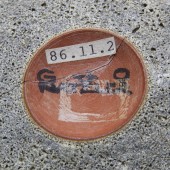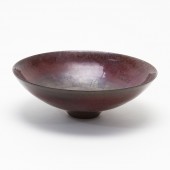![]() Printer version
Printer version
Gertrud Natzler, Gertrud Amon, and Otto Natzler
1908Born Vienna, Austria
1971Died Los Angeles, California
EDUCATION
1926Handelsakademie, Vienna, Austria
BIOGRAPHY
Gertrud Natzler and her husband, Otto, are known for their elegant, classical earthenware vessel forms that she threw and were glazed and fired by Otto. They were artistic collaborators for over 30 years.
Soon after meeting in Vienna, Austria, Gertrud encouraged Otto to take up ceramics. They worked in the workshop of Franz Iskra where they used commercially available glazes. In 1935 Otto and Gertrud set up their own studio and installed an electric kiln. Not knowing the correct firing temperatures or chemistry of commercially available glazes they had used in Iskra’s studio, the first firing failed. Otto applied his engineering discipline to research and develop a palette of glazes he liked and could control. He succeeded in 1935.
While Otto developed his glaze technology, Gertrud worked to refine her throwing skills. When she was able to throw eggshell thin earthenwares, she focused on her forms and refining the details. The division of labor that was maintained throughout their long collaboration established Otto as the glaze and kiln master with his wife, Gertrud, the throwing master.
In 1938, one year after winning the Silver Medal at the Paris International Exposition, Otto and Gertrud were married and immigrated to America where they worked for over thirty years. When their belongings arrived from Austria, they were able to set up their own ceramics studio in a duplex on South Street, Andrews Place, Los Angeles where they lived, worked and had a gallery. Otto worked to market their wares, initially with little success. This would quickly change, however, beginning in 1939 when the Natzler’s earned first place in the Syracuse Museum of Fine Art’s (Everson), Ceramic National, Syracuse, New York.
Although they did not teach, the impact of their arrival was felt in the educational ceramics programs around California. At the time, many of these programs focused on hand-built ceramics. Gertrud’s unique fly wheel potter’s wheel re-kindled the interest in thrown pots by providing a method by which to throw highly refined pots. This technology was integrated and used widely thereafter in many of the ceramics departments.
The Natzler’s were also influential in their use of native clays. California potters had long been importing clay from other states. Otto searched for a fine California native clay, succeeding in 1939, and using that clay to produce the winning vessel at the Ceramic National in Syracuse. Again, the Natzler’s techniques impacted ceramic teaching programs.
Initially, their ceramics were classic forms with dry, earthy and lava glazes. In 1942 Otto began to work with reduction firing and produce a wider range of glazes. Their work evolved to include subtle allusions to Chinese and Scandinavian ceramics.
Both Gertrud and Otto continued throughout their careers to invent and improve their work. Recognized internationally for their finely thrown, glazed and fired ceramics, Gertrud continued to evolve ever more refined forms while, after the 1950s, Otto began to refocus his concentration on manipulating on refining his kiln mastery to effect the glazes. He experimented with drafts, ashes, use of smoke and choice of reducing agent. Between 1938 and 1950, the Natzlers expanded their repertoire of distinctive opaque glazes to include:
1939 “Pompei” glazes, first produced in 1939, pock marks, blisters and shriveled patterns;
1940 “Lava” glazes, with rough, textured surfaces including three different textures Lava glazes, Flowing Lava glazes, and Lavastone glazes;
1942 “Reduction” glazes;
1942 “Iridescence”;
1944 "Melt Fissures" an accidental effect first produced in a control ”Smoke and Fire Marks” with traces of kiln flame licking the exterior (not really used until
1960); and
1948 “Crater”glazes similar to “Pompeii” glazes but with deeper craters and less blistering
1956 Crystalline Glazes
There are at least 20,000 elegant vessels, bottles and bowls thrown by Gertrud, each of which was glazed with one of the thousands of glazes Otto perfected. After the death of Gertrud in 1971, Otto glazed the remaining vessels thrown by Gertrud, and then in 1974 began to work on his own slab-construction sculptural pots.
See Otto Natzler for more information.
PUBLIC COLLECTIONS
Art Institute of Chicago, Chicago, Illinois
Contemporary Museum, Honolulu, Hawaii
Crocker Museum, Sacramento, California
Everson Museum of Art, Syracuse, New York
Grace Museum, Abilene, Texas
Los Angeles County Museum of Art (LACMA), Los Angeles, California
Metropolitan Museum of Art, New York, New York
Museo Internazionale delle Ceramiche, Faenza, Italy
Museum of Arts and Design, New York, New York
Museum of Modern Art, New York, New York
Nelson-Atkins Museum of Art, Kansas City, Missouri
Smithsonian American Art Museum, Renwick Gallery, Washington, D.C.
Smithsonian Cooper-Hewitt National Design Museum, New York
Victoria and Albert Museum, London, England
BIBLIOGRAPHY
Form and Fire: Natzler Ceramics, 1939-1972. Washington: Published for the Renwick Gallery of the National Collection of Fine Arts by the Smithsonian Institution Press, 1973.
Gertrud and Otto Natzler, A Retrospective Exhibition (15th June - 14th August 1966). Los Angeles, CA: Los Angeles County Museum of Art, 1966.
The Jewish Museum. Ceramics an Exhibit: Gertrud and Otto Natzler. New York, NY: The Jewish Museum, 1958.
Kardon, Janet. Gertrud and Otto Natzler: Collaboration/Solitude. New York, NY: American Craft Museum, 1993.
Lynn, Martha Drexler. American Studio Ceramics: Innovation and Identity, 1940-1979. New Haven, CT: Yale University Press, 2015.
Natzler, Otto, Senta Raizen and Ian McKibbin White. The Ceramic Work of Gertrud and Otto Natzler. San Francisco, CA: M.H. de Young Memorial Museum, 1971.
Natzler, Gertrud and Otto. Catalog of the Collection of Mrs. Leonard M. Sperry and a Monograph by Otto Natzler. Los Angeles, CA: Los Angeles County Museum of Art, 1968.
Method: Thrown
Dimensions: H. 4.75 x W 11.13 x D 11.25 inchesSurface Technique: Glaze
Citation: . "The Marks Project." Last modified March 5, 2024. http://www.themarksproject.org:443/marks/natzler-0

















